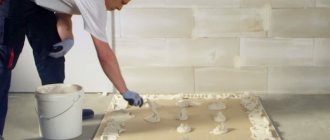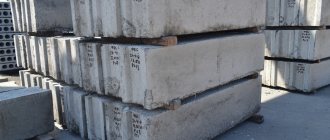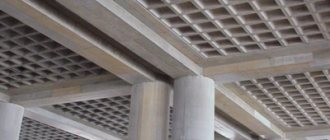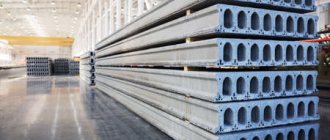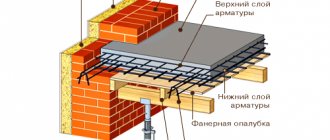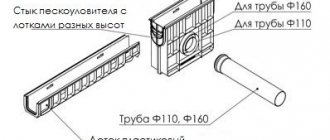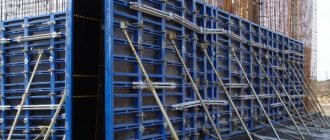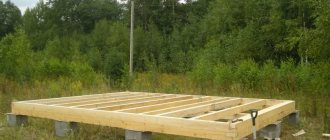Everything you need to know about floors before starting construction
Floors are the internal horizontal enclosing structures of a residential building, dividing it in height into floors and giving additional rigidity to the entire building. This is the most important element of the structure of the house. The safety, health and peaceful rest of people largely depend on its condition.
Floors located above basements are called above basements; those separating the upper floor from the attic are called attics; those located between adjacent floors are called interfloor. Depending on the method of transferring the loads perceived in the building, floors are divided into without beams and beams.
Construction and classification of floors
The floors are both prefabricated - from load-bearing beam elements and enclosing structures - and solid. Regardless of the design, it is the load-bearing and enclosing part of the house, subject to increased loads. The requirements for floors vary depending on the type.
- Basement.
- Attics.
- Interfloor.
The basement floor must withstand 200 kg/m², and for the attic floor 100 kg/m² is usually sufficient, since the load on it is less. In addition, basement, basement and attic floors meet the scope of application - coupled with strength and rigidity, high thermal insulation parameters. This is achieved by using specialized insulating materials (insulation, membranes) in the “pie”.
For interfloor ceilings, temperature and humidity conditions are not as critical as resistance to static and dynamic loads, especially when it comes to wooden beam structures. Miscalculations in the design and installation of wooden interfloor ceilings lead to the “trampoline” effect. The thermal insulation layer maintains a uniform, comfortable temperature on each floor. Thermal insulation combines minimal thermal conductivity with soundproofing properties - one material both retains heat and dampens sound. Of course, silence cannot be achieved only with thermal insulation; complex solutions are used for these purposes, but it is possible to achieve a sufficient level of comfort.
Types of floors
Floors are classified according to the specific application and other parameters.
- Based on the materials of the supporting base.
- According to the device method.
Based on materials, the base of the floor is wooden, metal and reinforced concrete. Wooden floors are assembled from solid timber and spliced boards; if the span or load exceeds the permissible value, either factory-made I-beams or home-made glued structures are used. As for metal, steel I-beams and reinforced concrete beams are used less frequently in the private sector.
According to the method of installation, floors are divided into three groups: prefabricated (beams, slabs), monolithic (simple, lightweight) and prefabricated monolithic. When constructing country houses using frame technology or log buildings from timber or logs, the floors are predominantly prefabricated, made of wooden beams. In stone houses there are slabs, reinforced concrete or prefabricated monolith in the basement/basement and interfloor ceilings and wooden beams in the attic.
conclusions
Different floors are used for different types of houses, and it is better for the designer to calculate them.
It is clear that after reading the article there will still be people who think that design is an unnecessary extortion of money. In principle, this is their problem.
But for the rest it should become a law - builders don’t build without a project! Anyone who builds without a plan is not a builder!
Prefabricated floors
Prefabricated floors are divided into beam and slab; in the first case, the load-bearing beams are assembled with enclosing structures; in the second, ready-made reinforced concrete slabs are used.
Prefabricated wooden floor
A typical wooden floor includes several layers.
- Logs (beams) are load-bearing, usually made of softwood timber of at least second grade, with a rectangular cross-section. The height is one and a half to two times the width; the specific section depends on the span length and the expected load. Like other wooden elements, logs are impregnated with a universal composition (fire and bioprotection) or separately with an antiseptic and fire protection. Supporting the ends of the logs on stone walls is possible with a blind or open seal, but in both cases the supporting part is waterproofed. The distance between the lags is predominantly 600 mm, for ease of use of slab insulation and subfloors.
YuryFORUMHOUSE Member
Typically, the pitch between the lags is taken based on the width of the insulation (600mm). The same step is considered normal for working with 36-38 mm floor boards. Well, the height is adjusted to the span. In addition to the maximum deflection in the middle of the span, there is also instability of the ceiling. Typically, beams of 50x200 mm, 100x150 mm, 100x200 mm are used. When it comes to the basement floor and the loads are higher and the humidity is higher, it is worth choosing more reliable beams.
- Thermal insulation – slab, roll, backfill, sprayed (stone wool, expanded clay, ecowool, polyurethane foam, etc.). The thickness of the insulation layer depends on the selected material and thermal resistance standards in the region of construction, on average it is 200 mm for a basement floor. There is a gap between the insulation and the subfloor for ventilation. If the height of the logs is not enough, a wooden block of the required thickness is placed under the flooring.
- Waterproofing.
- Vapor barrier.
- Flooring - to lay the insulation, a skull block is stuffed onto the joists, on top of which the flooring is assembled from a rough board without the use of fasteners.
- Subfloor - not only tongue-and-groove boards laid directly on the joists are used as a finishing coating, but various composites that require a plank or slab base.
The lower wooden floor is combined with lightweight, columnar or pile foundations, less often with strip foundations. In some cases, floors on wooden joists are laid on top of monolithic bases for additional insulation.
Prefabricated slab floor
In brick, stone and monolithic houses, mainly monolithic or large-format prefabricated floors are made from factory-made hollow-core reinforced concrete slabs. The standard slab thickness is 220 mm, length 2.4-6.8 m, width 1.2-1.5 m, weight 0.9-2.5 tons. This type of flooring is one of the most popular, especially in houses with basements or large basements.
The installation algorithm is as follows.
- Preparation of the base - the plane of the foundation for the slab floor needs to be level, small differences, up to 50 mm, are leveled with a layer of cement-sand mortar. The base and slabs must be separated by a layer of waterproofing, or mastic or a weld coating is used. When laying interfloor ceilings, sometimes an armored belt is needed (if the walls are made of fragile masonry materials).
- Preparing the slabs - to prevent moisture from getting into the slabs themselves, the voids at the ends are sealed to a small (10-15 cm) depth with either rubble and thick cement mortar, or insulation and mortar.
- Laying slabs - the slabs rest on the foundation or walls with two short sides, the long side remains hanging. The depth of support of the slabs depends on the type of base: on a brick it goes at least 125 mm, on concrete 60-70 mm is enough, on porous blocks based on concrete the slabs go 12-15 cm. And this is not the case when the deeper, the more reliable , maximum is 20 cm. Mounting lugs (if any) are tied or welded using reinforcement. It is better to lay it on a layer of TsPS M100, it will act as a kind of lubricant, and it will be easier to turn the slabs.
- Sealing seams - thin seams are sealed with a DSP solution; fine crushed stone is added to the solution for sealing thick ones.
Nikolay_KurkinForumHouse Member
Sealing of joints between slabs must be done with high-quality concrete to prevent their warping (work according to the key scheme), for which recesses are usually provided in the slabs for the formation of dowels.
- Preparation for the finished floor - if the surface of the slabs is relatively flat, and there is no plan for an underfloor heating system or a finishing coating that requires an ideal plane, you can do without pouring a rough screed. Thick preparation is replaced with a thin-layer self-leveling mixture or a specialized substrate.
Laying such massive structures requires the use of special equipment, which somewhat limits the application, since not every house under construction will have access to special equipment.
8.1. General provisions
Floors
are the main horizontal structural elements of a building, dividing it in height into levels (floors) and simultaneously performing load-bearing functions.
The floor structures are formed by horizontal hard disks (diaphragms). They combine the vertical load-bearing structures of the building, ensuring its operation under the influence of vertical and horizontal loads as a single whole. Floors transfer permanent (partitions) and temporary (furniture, equipment, people) vertical loads to the walls or columns of the building (Fig. 8.1.).
Rice. 8.1. Types of floors and impacts on them: 1 – above-basement; 2 – basement; 3 – interfloor; 4 – attic; 5 – power load; 6 – impact noise; 7 - airborne noise; 8 – heat flow; 9 – diffusion of water vapor; 10 – drops from the roof
Force influences
cause stress and deformation of floor elements, most clearly manifested in deflections.
Non-force influences
cause the need to give the floors the appropriate thermal, acoustic, waterproofing, fireproof and other qualities that meet the operating requirements.
Monolithic floors
Unlike prefabricated reinforced concrete slabs, monolithic floors do not have seams and do not require the use of lifting equipment. Monolithic floors in houses without a basement are usually interfloor, since it is not practical to cast the floor itself - it is more logical to either build a slab foundation, immediately obtaining a subfloor, or to pour the floors over the ground during the process of finishing the house.
Monolithic type ceiling - a solid reinforced concrete slab, supported by load-bearing walls and partitions; if necessary, support columns are also cast or laid out. All characteristics of the monolith are calculated during the design process of the house. The thickness of the floor is determined based on the size of the largest span (typical ratio 1:30), but not less than 15 cm. For spans up to 6 meters in length, the average thickness is about 20 cm; if it is necessary to fill a floor with spans larger than this value, reinforcement with stiffeners will be required. Pouring the slab is carried out in several stages.
- Preparation - assembling formwork from panels and supports, homemade formwork is usually made of thick (from 20 mm) moisture-resistant plywood, but it can also be plastic or metal. If a suspended ceiling is not planned, in which a flat plane is not necessary, the surface of the boards should be smooth. Supports can be specialized (metal, telescopic) or homemade (logs, beams with supports). Homemade formwork is assembled using hardware and timber; ready-made collapsible structures have factory fastenings. To seal homemade formwork, it is covered with thick plastic film; the prefabricated form is airtight, but to simplify the removal of formwork it must be lubricated. The assembled form is checked for compliance with the level so that it does not warp.
- Reinforcement - a spatial reinforcement frame is knitted from steel reinforcement, the diameter and mesh cell are calculated during design. To knit the reinforcement, use wire 1.2-1.5 mm thick; rigid fixation (welding) is unacceptable. To maintain the protective layer when pouring, the frame is installed on special clamps. During the assembly of the reinforcement frame, mortgages for communications are also installed.
- Pouring - the use of self-mixing mortar for concreting a monolith is rare; it is a necessary measure if it is not possible to order a ready-made mortar. Basically, the slab is filled with factory-made mortar (from M200), in one go, using a concrete pump: the mass is evenly distributed over the entire area and compacted with a vibrator.
- Caring for the slab - until the monolith reaches brand strength, it is cared for like other concrete surfaces, with the difference that instead of abundant watering, wetting.
Wall mount
Beams are attached to walls using several methods:
- Sealing into wall grooves. They are usually used in timber and brick buildings. You need to drill deep grooves, lay the ends of the beams, then create waterproofing;
- Use of metal supports. They are attached using screws or self-tapping screws. This option is technologically advanced and does not take much time, but in terms of reliability it is inferior to the previous one.
Lightweight monolithic floors
While there are many advantages, the disadvantages of monolithic floors include heavy weight and the need to assemble and dismantle sealed formwork with a smooth surface. A lightweight type of monolithic ceiling, poured over a profiled sheet, is free from these disadvantages. Initially, this type of flooring was developed for industrial facilities, but is now used in private homes. The profiled sheet is a permanent formwork, which somewhat simplifies the process of installing the ceiling. For a support-free lightweight monolithic floor, a load-bearing profile sheet with a tongue of 60 mm or more, 0.7 mm thick or more, and a reinforcement frame are used. The corrugated sheet is laid with the narrow part of the corrugation down, in waves against the length of the span, the reinforcement frame consists of longitudinal reinforcement, transverse reinforcement and mesh. In fact, it turns out to be a type of ribbed monolithic floor, less thick than a conventional monolithic slab. This variety is also used as a basement floor.
BarmenFORUMHOUSE Member
Floor of the first floor: clear span 3.5 m, profile sheet H 60, galvanized 0.7 mm, bottom reinforcement 14, top 8, mesh with mesh 50×50 mm, thickness 4 mm, transverse reinforcement 8, bent in three waves. The height of the monolith is 145 mm, then EPPS 50 mm, then mesh and screed 65 mm.
Lightweight ribbed monolith is an alternative to other types of floors during reconstruction.
SorelliForumHouse Member
Mice have taken up residence in the wooden floors of the house. It was decided to replace them with concrete ones. Foundation grillage according to TISE. Foam block walls. The maximum span length is 3 m. I used 114 profile 1 mm, double reinforcement 10 inside, welded mesh 100x100x3 mm on top. Everything worked out great! I recommend it to everyone. Better than wood floors, and the cost is low.


